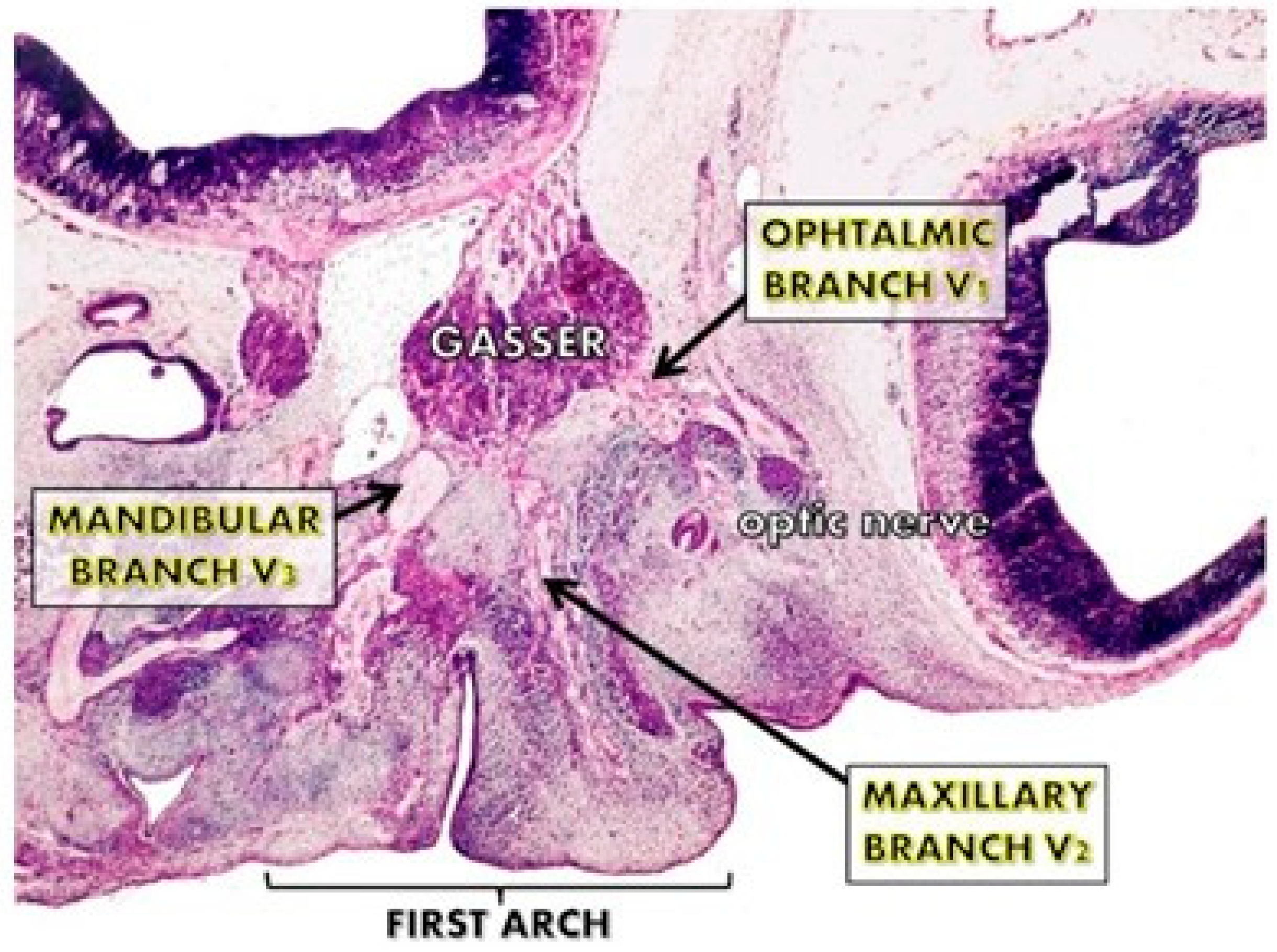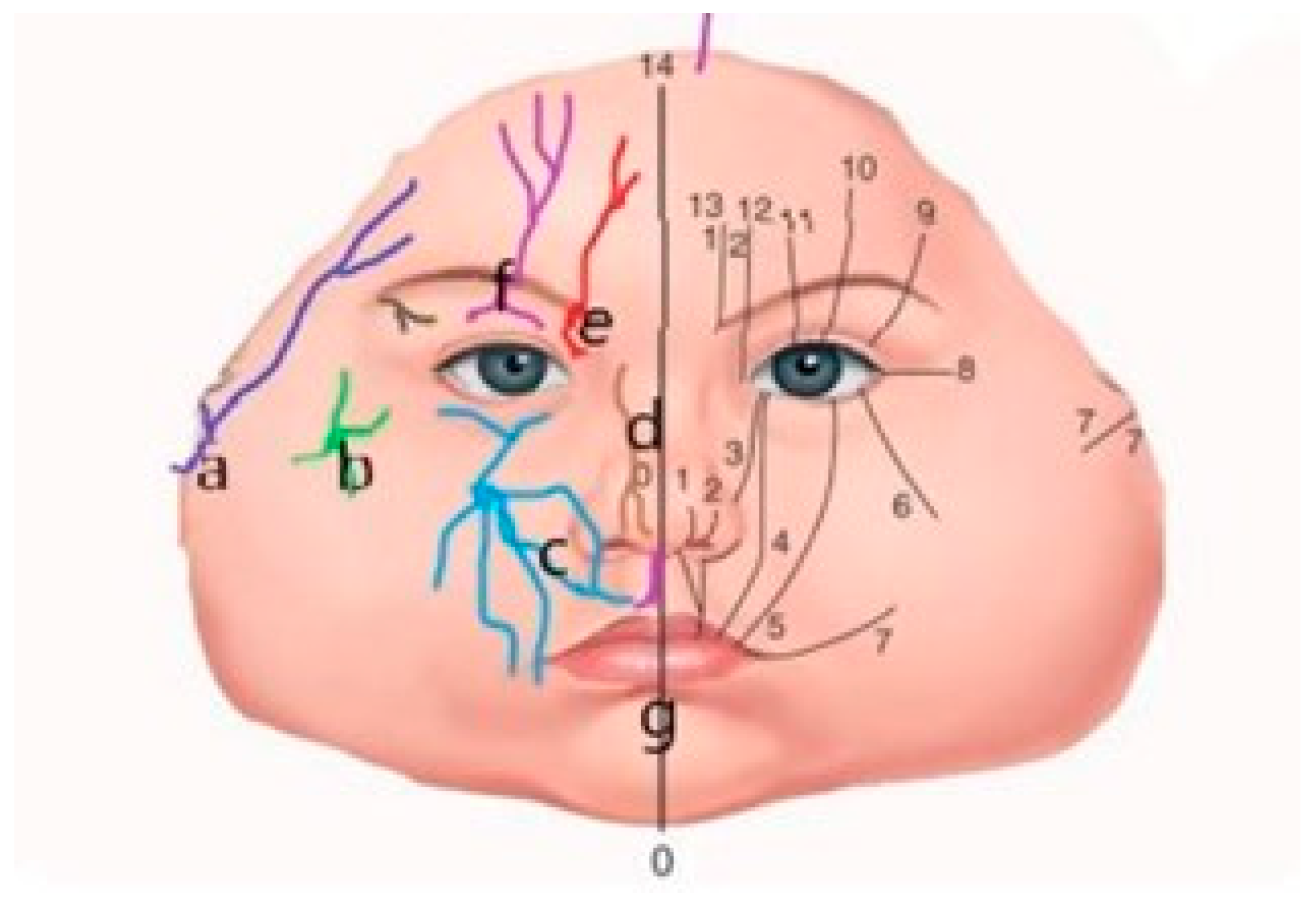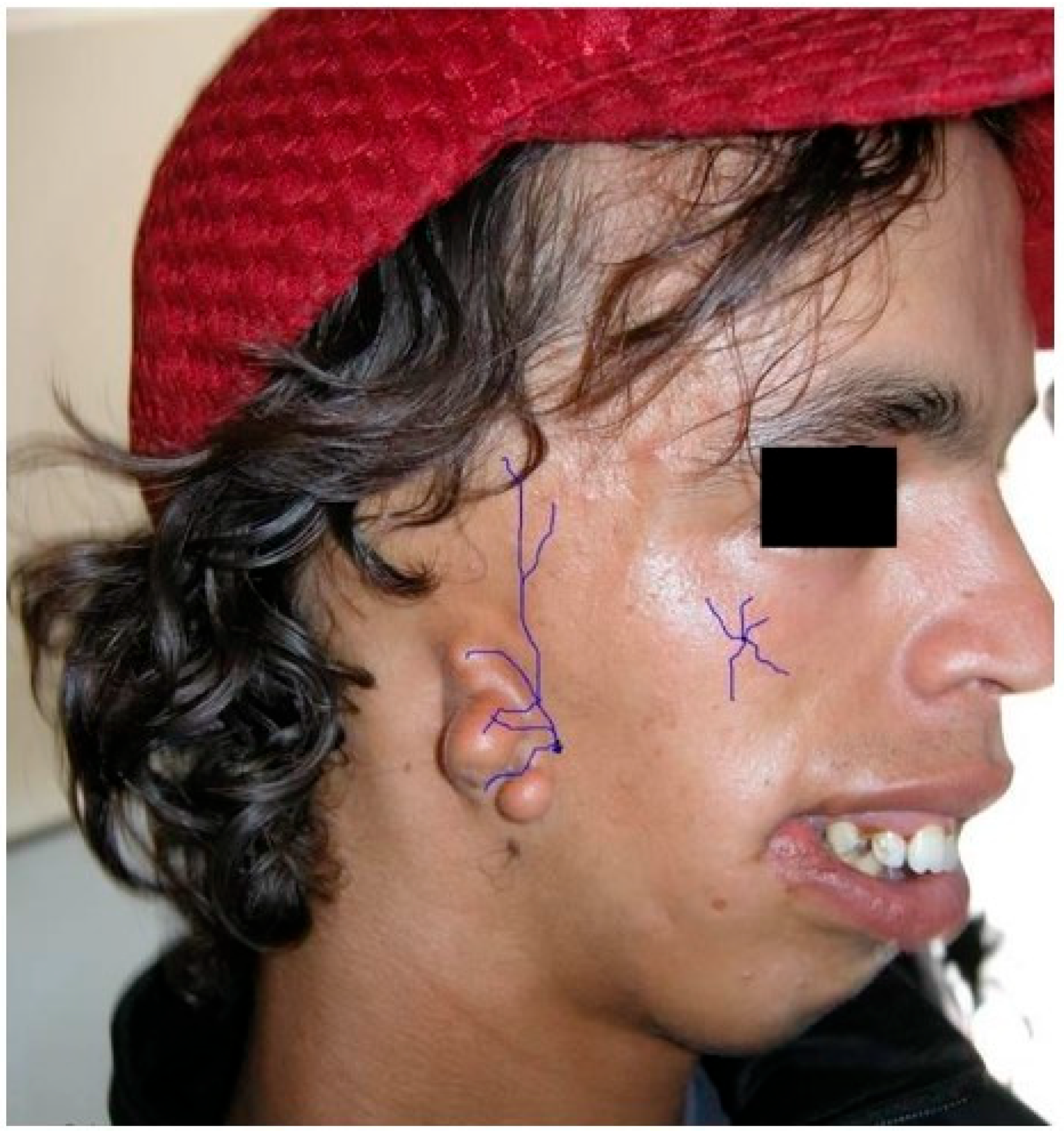Facial Clefts and the Trigeminal Nerve: A Narrative Review of the Literature and Clinical Considerations in the Era of Personalized Medicine
Abstract
1. Introduction
The Trigeminal Nerve and the Development of the Face
2. Discussion—Narrative Review
3. Conclusions
Author Contributions
Funding
Institutional Review Board Statement
Informed Consent Statement
Data Availability Statement
Conflicts of Interest
References
- Beherens, R.G.; Johnston, L.E. The influence of the trigeminal nerve on facial growth and development. Am. J. Orthod. 1984, 85, 199–206. [Google Scholar] [CrossRef]
- Kjaer, I. Correlated appearance of ossification and nerve Tissue in human fetal jaws. J. Craniofac. Genet. Dev. Biol. 1990, 10, 329–336. [Google Scholar]
- Kollar, E.J.; Lumsden, A.G. Tooth morphogenesis: The role of the innervation during induction and pattern formation. J. Biol. Buccale 1979, 7, 49–60. [Google Scholar]
- Gardner, D.E.; Luschei, E.S.; Joondeph, D.R. Alterations in the facial skeleton of the guinea pig following a lesion of the trigeminal motor nucleus. Am. J. Orthod. 1980, 78, 66–80. [Google Scholar] [CrossRef]
- Aleksis, S.; Budzilowvich, G.; Reuben, R.; Feigin, I.; Finegold, M.; McCarthy, J.; Aston, S.; Converse, J.M. Congenital trigeminal neuropathy in oculoauriculovertebral dysplasia-hemifacial microsomia. J. Neurol. Neurosurg. Psychiatry 1975, 38, 1033–1035. [Google Scholar] [CrossRef]
- Cannistrà, C.; Barbet, J.P.; Houette, A.; Loro Marchese, J.; Iannetti, G. Mandibulo-facial Dysostosis: Comparison study between a neonate with mandibulo-facial dysostosis and a normal neonate. J. Cranio-Maxillofac. Surg. 1998, 26, 92–97. [Google Scholar] [CrossRef] [PubMed]
- Cannistrà, C.; Barbet, J.P.; Houette, A.; Iannetti, G. Temporomandibular region in the Franceschetti’s syndrome. Anatomical study. Bull. Groupe Int. Rech. Sci. Stomatol. Odontol. 1999, 41, 33–38. [Google Scholar]
- Cannistrà, C.; Barbet, J.P.; Parisi, P.; Iannetti, G. Cyclopia: A radiological and anatomical craniofacial postmortem study. J. Cranio-Maxillofac. Surg. 2001, 29, 150–155. [Google Scholar] [CrossRef]
- Cannistra, C.; Bontemps, C.; Valero, R.; Iannetti, G.; Barbet, J.P. Orbitofacial cleft number 5: Radiographic, anatomical and histologic study of a 24-week-old fetus. Plast. Reconstr. Surg. 2006, 18, 1538–1542. [Google Scholar] [CrossRef] [PubMed]
- Smit, J.A.; Jacobs, K.; Bais, B.; Meijer, B.; Seinen, M.N.; de Bree, K.; Veldhuis, T.; Hagoort, J.; de Jong, K.H.; Breugem, C.C.; et al. A three-dimensional analysis of the development of cranial nerves in the human embryo. Clin. Anat. 2022, 35, 666–672. [Google Scholar] [CrossRef] [PubMed]
- Moody, S.A.; Heaton, M.B. Developmental relationships between trigeminal ganglia and trigeminal motoneurons in chick emb c zryos. II. Ganglion axon ingrowth guides motoneuronmigration. J. Comp. Neurol. 1983, 213, 344–349. [Google Scholar] [PubMed]
- Cox, J.A.; LaMora, A.; Johnson, S.L.; Voigt, M.M. Diverse mechanisms for assembly of branchiomeric nerves. Dev. Biol. 2011, 357, 305–317. [Google Scholar] [CrossRef]
- Kurosaka, H.; Iulianella, A.; Williams, T.; Trainor, P.A. Disrupting hedgehog and WNT signalling interactions promotes cleft lip pathogenesis. J. Clin. Investig. 2014, 124, 1660–1671. [Google Scholar] [CrossRef]
- Kurosaka, H.; Trainor, P.A.; Leroux-Berger, M.; Iulianella, A. Cranial nerve development requires co-ordinated Shh and canonical Wnt signaling. PLoS ONE 2015, 10, e0120821. [Google Scholar] [CrossRef]
- Miyahara, N.; Shirasaki, R.; Tashiro, Y.; Muguruma, K.; Heizman, C.W.; Murakami, F. Pathfinding and growth termination of primary trigeminal sensory afferents in the embryonic rat hindbrain. J. Comp. Neurol. 2003, 460, 503–513. [Google Scholar] [CrossRef]
- Lumsden, A.G.; Davies, A.M. Earliest sensory nerve fibres are guided to peripheral targets by attractants other than nerve growth factor. Nature 1983, 306, 786–788. [Google Scholar] [CrossRef] [PubMed]
- Lumsden, A.G.; Davies, A.M. Chemotrophic effect of specific target epithelium in the developing mammalian nervous system. Nature 1986, 323, 538–539. [Google Scholar] [CrossRef] [PubMed]
- Rochlin, W.; Farbman, A.I. Trigeminal ganglion axons are repelled by their presumptive targets. J. Neurosci. 1998, 18, 6840–6842. [Google Scholar] [CrossRef]
- Storey, A.T.; Kenny, D.J. Growth, development, and aging or orofacial tissues: Neural aspects. Adv. Dent. Res. 1989, 3, 14–29. [Google Scholar] [CrossRef]
- Davies, A.M. The growth rate of sensory nerve fibres in the mammalian embryo. Development 1987, 100, 307–311. [Google Scholar] [CrossRef]
- Johnson, E.M.; Rich, K.M.; Yip, H.K. The role of NGF in sensory neurons in vivo. Trends Neurosci. 1986, 9, 33–37. [Google Scholar] [CrossRef]
- Crair, M.C. Neuronal activity during development: Permissive or instructive? Neurobiology 1999, 9, 88–93. [Google Scholar] [CrossRef]
- Marx, J. Nerve growth factor: Regulatory role examined. Science 1974, 185, 930–932. [Google Scholar] [CrossRef]
- Sofroniew, M.V.; Howe, C.L.; Mobley, W.C. Nerve growth factor signaling, neuroprotection, and neural repair. Annu. Rev. Neurosci. 2001, 24, 1217–1281. [Google Scholar] [CrossRef]
- Burnstock, G.; Verkhratsky, A. Long term (trophic) purinergic signalling: Purinoceptors control cell proliferation, differentiation and death. Cell Death Disease 2010, 1, e9. [Google Scholar] [CrossRef]
- Petersen, J.; Adameyko, I. Nerve-associated neural crest: Peripheral glial cells generate multiple fates in the body. Curr. Opin. Genet. Dev. 2017, 45, 10–14. [Google Scholar] [CrossRef]
- Mukouyama, Y.; Shin, D.; Britsch, S.; Taniguchi, M.; Anderson, D. Sensory nerves determine the pattern of arterial differentiation and blood vessel branching in the skin. Cell 2002, 109, 693–705. [Google Scholar] [CrossRef] [PubMed]
- Mukouyama, Y.; Gerber, H.-P.; Ferrara, N.; Gu, C.; Anderson, D.J. Peripheral nerve-derived VEGF promotes arterial differentiation via neuropilin1-mediated positive feedback. Development 2005, 132, 941–952. [Google Scholar] [CrossRef] [PubMed]
- Sudiwala, S.; Knox, S.M. The emerging role of cranial nerves in shaping craniofacial development. Genesis 2019, 57, e23282. [Google Scholar] [CrossRef]
- Li, W.; Kohara, H.; Uchida, Y.; James, J.M.; Soneji, K.; Cronshaw, D.G.; Zou, Y.-R.; Nagasawa, T.; Mukouyama, Y.-S. Peripheral nerve-derived CXCL12 and VEGF-A regulate the patterning of arterial vessel branching in developing limb skin. Dev. Cell 2013, 24, 359–371. [Google Scholar] [CrossRef] [PubMed]
- Yang, L.; Xu, M.; Bhuiyan, S.A.; Li, J.; Zhao, J.; Cohrs, R.J.; Susterich, J.T.; Signorelli, S.; Green, U.; Stone, J.R.; et al. Human and mouse trigeminal ganglia cell atlas implicates multiple cell types in migraine. Neuron 2022, 110, 1806–1821.e8. [Google Scholar] [CrossRef]
- Chu, Y.; Jia, S.; Xu, K.; Liu, Q.; Mai, L.; Liu, J.; Fan, W.; Huang, F. Single-cell transcriptomic profile of satellite glial cells in trigeminal ganglion. Front. Mol. Neurosci. 2023, 16, 1117065. [Google Scholar] [CrossRef]
- Kim, J.I.; Imaizumi, K.; Thete, M.V.; Hudacova, Z.; Jurjuţ, O.; Amin, N.D.; Levy, R.J.; Scherrer, G.; et al. Human assembloid model of the ascending neural sensory pathway. Nature 2025, 642, 143–153. [Google Scholar] [CrossRef] [PubMed]
- Hampl, M.; Jandová, N.; Lusková, D.; Nováková, M.; Szotkowská, T.; Čada, Š.; Procházka, J.; Kohoutek, J.; Buchtová, M. Early embryogenesis in CHDFIDD mouse model reveals facial clefts and altered cranial neurogenesis. Dis. Model. Mech. 2024, 17, dmm050261. [Google Scholar] [CrossRef] [PubMed]
- Tessier, P. Anatomical classification of facial, cranio-facial and latero-facial clefts. J. Maxillofac. Surg. 1976, 4, 69–92. [Google Scholar] [CrossRef] [PubMed]
- Villaneuva, O.; Atkinson, D.S.; Lambert, S.R. Trigeminal nerve hypoplasia and aplasia in children with goldenhar syndrome and corneal hypoesthesia. J. Am. Assoc. Pediatr. Ophthalmol. Strabismus 2005, 9, 202–204. [Google Scholar] [CrossRef]
- Wang, R.; Li, Y.; Zhang, Y. High-resolution MRI findings of trigeminal nerve anomalies in patients with oculo-auriculo-vertebral spectrum. Front. Neurosci. 2021, 15, 649910. [Google Scholar] [CrossRef]
- Ranieri, G.; Bonardi, G.; Morani, V.; Panzica, G.C.; Tetto, F. Development of nerve fibres in the temporomandibular Joint of the human fetus. Anat. Embryol. 1996, 194, 57–64. [Google Scholar] [CrossRef]
- Packard, M.C.; Gilbert, M.C.; Tetrault, E.; Albertson, R.C. Zebrafish crocc2 mutants exhibit divergent craniofacial shape, misregulated variability, and aberrant cartilage morphogenesis. Dev. Dyn. 2023, 252, 1026–1045. [Google Scholar] [CrossRef]
- Danescu, A.; Mattson, M.; Dool, C.; Diewert, V.M.; Richman, J.M. Analysis of human soft palate morphogenesis supports regional regulation of palatal fusion. J. Anat. 2015, 227, 474–486. [Google Scholar] [CrossRef] [PubMed] [PubMed Central]
- Noble, A.; Qubrosi, R.; Cariba, S.; Favaro, K.; Payne, S.L. Neural dependency in wound healing and regeneration. Dev. Dyn. 2024, 253, 181–203. [Google Scholar] [CrossRef]
- Kousa, Y.A.; Zhu, H.; Fakhouri, W.D.; Lei, Y.; Kinoshita, A.; Roushangar, R.R.; Patel, N.K.; Agopian, A.J.; Yang, W.; Leslie, E.J.; et al. The TFAP2A-IRF6-GRHL3 genetic pathway is conserved in neurulation. Hum. Mol. Genet. 2019, 28, 1726–1737. [Google Scholar] [CrossRef]
- Robinson, K.; Curtis, S.W.; Leslie, E.J. The heterogeneous genetic architectures of orofacial clefts. Trends Genet. 2024, 40, 410–421. [Google Scholar] [CrossRef] [PubMed]
- Mitsiadis, T.A.; Luukko, K. Neurotrophins in odontogenesis. Int. J. Dev. Biol. 1995, 39, 195–202. [Google Scholar]
- Mitsiadis, T.A.; Graf, D. Cell fate determination during tooth development and regeneration. Birth Defects Res. C Embryo Today 2009, 87, 199–211. [Google Scholar] [CrossRef] [PubMed]
- Tuisku, F.; Hildebrand, C. Evidence for a Neural Influence on Tooth Germ Generation in a Polyphyodont Species. Dev. Biol. 1994, 165, 1–9. [Google Scholar] [CrossRef] [PubMed]
- Mohamed, S.S.; Atkinson, M.E. A histological study of the innervation of developing mouse teeth. J. Anat. 1983, 136, 735–749. [Google Scholar]
- Kaplan, M.M.; Hudacova, E.; Matejcek, M.; Tuaima, H.; Křivánek, J.; Machon, O. Mesenchymal Meis2 controls whisker development independently from trigeminal sensory innervation. eLife 2025, 14, e100854. [Google Scholar] [CrossRef]
- Mossey, P.A. Global perspectives in orofacial cleft management and research. Br. Dent. J. 2023, 234, 953–957. [Google Scholar] [CrossRef]
- Shull, L.C.; Artinger, K.B. Epigenetic regulation of craniofacial development and disease. Birth Defects Res. 2024, 116, e2271. [Google Scholar] [CrossRef]
- Capossela, L.; Gatto, A.; Ferretti, S.; Di Sarno, L.; Graglia, B.; Massese, M.; Soligo, M.; Chiaretti, A. Multifaceted Roles of Nerve Growth Factor: A Comprehensive Review with a Special Insight into Pediatric Perspectives. Biology 2024, 13, 546. [Google Scholar] [CrossRef]
- Peters, J.J.; Jacobs, K.; Munill, M.; Top, A.P.C.; Stevens, M.F.; Ronde, E.M.; Griot, J.P.W.D.; Lachkar, N.M.; Breugem, C.C. The Maxillary Nerve Block in Cleft Palate Care: A Review of the Literature and Expert’s Opinion on the Preferred Technique of Administration. J. Craniofac Surg. 2024, 35, 1356–1363. [Google Scholar] [CrossRef]
- Sun, S.; Lu, D.; Zhong, H.; Li, C.; Yang, N.; Huang, B.; Ni, S.; Li, X. Donors for nerve transplantation in craniofacial soft tissue injuries. Front. Bioeng. Biotechnol. 2022, 10, 978980. [Google Scholar] [CrossRef] [PubMed]
- Harrison, L.M.; Edison, R.L.; Hallac, R.R. Artificial Intelligence Applications in Pediatric Craniofacial Surgery. Diagnostics 2025, 15, 829. [Google Scholar] [CrossRef] [PubMed]
- Yan, F.; Suzuki, A.; Iwaya, C.; Pei, G.; Chen, X.; Yoshioka, H.; Yu, M.; Simon, L.M.; Iwata, J.; Zhao, Z. Single-cell multiomics decodes regulatory programs for mouse secondary palate development. Nat. Commun. 2024, 15, 821. [Google Scholar] [CrossRef] [PubMed]
- Shadad, O.; Chaulagain, R.; Luukko, K.; Kettunen, P. Establishment of tooth blood supply and innervation is developmentally regulated and takes place through differential patterning processes. J. Anat. 2019, 234, 465–479. [Google Scholar] [CrossRef] [PubMed]
- Kondo, S.; Schutte, B.C.; Richardson, R.J.; Bjork, B.C.; Knight, A.S.; Watanabe, Y.; Howard, E.; de Lima, R.L.F.; Daack-Hirsch, S.; Sander, A.; et al. Mutations in IRF6 cause Van der Woude and popliteal pterygium syndromes. Nat. Genet. 2002, 32, 285–289. [Google Scholar] [CrossRef]
- van den Boogaard, M.J.; Dorland, M.; Beemer, F.A.; van Amstel, H.K. MSX1 mutation is associated with orofacial clefting and tooth agenesis in humans. Nat. Genet. 2000, 24, 342–343, Erratum in: Nat. Genet. 2000, 25, 125. [Google Scholar] [CrossRef]
- Sulik, K.K.; Smiley, S.J.; Turvey, T.A.; Speight, H.S.; Johnston, M.C. Pathogenesis of cleft palate in Treacher Collins, Nager, and Miller syndromes. Cleft Palate J. 1989, 26, 209–216. [Google Scholar]
- Kjaer, I.; Keeling, J.W.; Fischer Hansen, B.; Becktor, K.B. Midline skeletodental morphology in holoprosencephaly. Cleft Palate Craniofac. J. 2002, 39, 357–363. [Google Scholar] [CrossRef]
- Foltz, L.; Avabhrath, N.; Lanchy, J.M.; Levy, T.; Possemato, A.; Ariss, M.; Peterson, B.; Grimes, M. Craniofacial chondrogenesis in organoids from human stem cell-derived neural crest cells. iScience 2024, 27, 109585. [Google Scholar] [CrossRef] [PubMed]
- Xie, G.; Zhang, F.; Leung, L.; Mooney, M.A.; Epprecht, L.; Norton, I.; Rathi, Y.; Kikinis, R.; Al-Mefty, O.; Makris, N.; et al. Anatomical assessment of trigeminal nerve tractography using diffusion MRI: A comparison of acquisition b-values and single- and multi-fiber tracking strategies. Neuroimage Clin. 2020, 25, 102160. [Google Scholar] [CrossRef] [PubMed]





| Timing of Nerve Damage | Cleft Types (Examples) | Clinical Features | Proposed Mechanism |
|---|---|---|---|
| Early embryonic (≤10 weeks, before CS23) | Tessier 6, 7, 8; 10–12; 0 (early form) | Superficial continuity preserved; deep pseudo-fibrotic tissue; agenesis of innervated mesenchyme | Loss of NGF/neurotrophic input before tissue differentiation; ectodermal migration covers defect |
| Late embryonic/early fetal (>10 weeks) | Tessier 1–5; 0 (late form) | Complete cleft with loss of tissue continuity; necrosis of denervated areas | Failure of growth factor support after tissue differentiation; loss of trophic activity of nerve endings |
| Alternative/overlapping causes | Syndromic clefts, atypical presentations | Genetic mutations (IRF6, MSX1), vascular anomalies, teratogens | Non-neural pathways contributing independently or synergistically |
Disclaimer/Publisher’s Note: The statements, opinions and data contained in all publications are solely those of the individual author(s) and contributor(s) and not of MDPI and/or the editor(s). MDPI and/or the editor(s) disclaim responsibility for any injury to people or property resulting from any ideas, methods, instructions or products referred to in the content. |
© 2025 by the authors. Licensee MDPI, Basel, Switzerland. This article is an open access article distributed under the terms and conditions of the Creative Commons Attribution (CC BY) license (https://creativecommons.org/licenses/by/4.0/).
Share and Cite
Lucangeli, N.; Cannistrà, M.S.; Scopelliti, D.; Parisi, P.; Tripodi, D.; Barbet, P.; Cannistrà, C. Facial Clefts and the Trigeminal Nerve: A Narrative Review of the Literature and Clinical Considerations in the Era of Personalized Medicine. J. Pers. Med. 2025, 15, 556. https://doi.org/10.3390/jpm15110556
Lucangeli N, Cannistrà MS, Scopelliti D, Parisi P, Tripodi D, Barbet P, Cannistrà C. Facial Clefts and the Trigeminal Nerve: A Narrative Review of the Literature and Clinical Considerations in the Era of Personalized Medicine. Journal of Personalized Medicine. 2025; 15(11):556. https://doi.org/10.3390/jpm15110556
Chicago/Turabian StyleLucangeli, Natalia, Matilde S. Cannistrà, Domenico Scopelliti, Pasquale Parisi, Domenico Tripodi, Patrick Barbet, and Claudio Cannistrà. 2025. "Facial Clefts and the Trigeminal Nerve: A Narrative Review of the Literature and Clinical Considerations in the Era of Personalized Medicine" Journal of Personalized Medicine 15, no. 11: 556. https://doi.org/10.3390/jpm15110556
APA StyleLucangeli, N., Cannistrà, M. S., Scopelliti, D., Parisi, P., Tripodi, D., Barbet, P., & Cannistrà, C. (2025). Facial Clefts and the Trigeminal Nerve: A Narrative Review of the Literature and Clinical Considerations in the Era of Personalized Medicine. Journal of Personalized Medicine, 15(11), 556. https://doi.org/10.3390/jpm15110556






